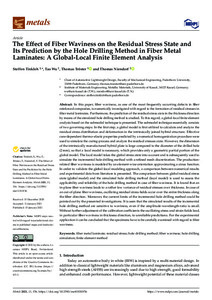| dcterms.abstract | In this paper, fiber waviness, as one of the most frequently occurring defects in fiber reinforced composites, is numerically investigated with regard to the formation of residual stresses in fiber metal laminates. Furthermore, the prediction of the residual stress state in the thickness direction by means of the simulated hole drilling method is studied. To this regard, a global-local finite element analysis based on the submodel technique is presented. The submodel technique essentially consists of two governing steps: In the first step, a global model is first utilized to calculate and analyze the residual stress distribution and deformation in the intrinsically joined hybrid structure. Effective cure-dependent thermo–elastic properties predicted by a numerical homogenization procedure were used to simulate the curing-process and analyze the residual stresses state. However, the dimension of the intrinsically manufactured hybrid plate is large compared to the diameter of the drilled hole (2 mm), so that a local model is necessary, which provides only a geometric partial portion of the global model. The local model takes the global stress state into account and is subsequently used to simulate the incremental hole drilling method with a refined mesh discretization. The production-related fiber waviness is modeled by an element-wise orientation approximating a sinus function. In order to validate the global-local modeling approach, a comparison between numerical results and experimental data from literature is presented. The comparison between global residual stress state (global model) and the simulated hole drilling method (local model) is used to assess the applicability and reliability of the hole drilling method in case of fiber waviness. It is found that an in-plane fiber waviness leads to a rather low variance of residual stresses over thickness. In case of an out-of-plane fiber waviness, oscillating residual stress fields occur over the entire thickness along the fiber direction. Moreover, the current limits of the incremental hole drilling method could be pointed out by the presented investigations. It is seen that the simulated results of the incremental hole drilling method are sensitive to waviness, even if the amplitude-wavelength-ratio is small. Without further adjustment of the calibration coefficients the oscillating stress and strain fields lead, in particular fiber waviness in thickness direction, to unreliable predictions. For the experimental application it can be concluded that the specimens have to be carefully examined with regard to fiber waviness. | eng |


